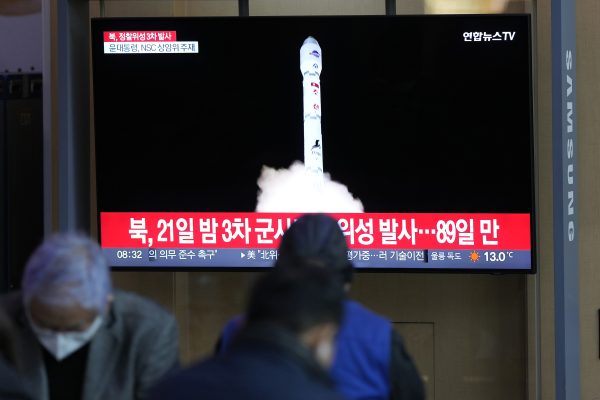Late in the evening on November 21, an hour earlier than the officially announced launch time of midnight, North Korea made another attempt to launch a military spy satellite. Not only was the launch window supposed to have been ten days, but the weather was good, so there was no apparent rational reason for the false start. Perhaps the North Koreans were trying to outfox Japan, the United States, and South Korea, who were all watching closely. If that were the case, though, why announce the launch at all? Or maybe Supreme Leader Kim Jong-Un had shown up at the site and ordered the launch to go early, with officials unable to protest?
The Korean Central News Agency promptly reported that the launch had been a “success.” Japan, the United States, and South Korea initially stated that they were not able to confirm the satellite entering orbit, but they later verified that it had. Upon seeing satellite images of American military bases on Guam and elsewhere, Kim boasted that North Korea has now “gained spy satellite capability through its own efforts and technological ability” and “‘eyes’ overlooking a very long distance and a strong ‘fist’ beating a very long distance.” The military spy satellite gives North Korea the eyes that enable precision strikes with nuclear missiles.
The country’s satellite development policy was clarified in the “five-year plan for the development of the defense science and the weapon system” that was adopted by the 8th Congress of the Workers’ Party of Korea in January 2021. In December 2022, Kim issued instructions that the launch should take place “within the shortest period possible,” but this success was ultimately achieved only after two failures and almost a year. Kim visited the National Aerospace Development Administration in April 2023 and then the Non-Standing Satellite Launch Preparation Committee in May, notably with major media coverage of his daughter accompanying him on both occasions.
There were very few reports about Kim’s activities during this period, so his repeated on-site instructions about spy satellites suggest that this was of significant personal interest to him.
Meanwhile, the Supreme Leader’s “beloved daughter” also attended the celebratory banquet held immediately after the successful launch. The banquet took place at the Mokran Pavilion in Pyongyang. This is the country’s most luxurious banquet hall, which has served as an inter-Korean summit venue. It was the first time in six years that it had been used in the context of arms development, which suggests that the satellite launch was seen as an auspicious event on a par with the 2017 ICBM launch.
It is already more than a year since Kim’s daughter began appearing in public, her presence only becoming more and more pronounced over the months. It remains too early to say with certainty that she is being groomed as Kim’s successor, but it is clear that she is seen as very special and it would appear that the groundwork is being laid to make her supreme leader in strictly male-dominated North Korea. As such, these visits might be a step toward establishing a “revolutionary history” of Kim’s daughter having made great contributions to the development of military spy satellites.
So North Korea is celebrating its successful launch, but being able to get a satellite into orbit and send back images is just a first step. Multiple spy satellites need to be launched before they are useful. Japan, for instance, operates more than ten. Nonetheless, North Korea is as always being true to its word when it comes to arms development, steadily making progress in technological innovation amid extreme poverty, so this development is something that needs to be taken seriously.
One question is the role of Russia in all this. Following Russian Defense Minister Sergei Shoigu’s visit to North Korea in July, Russia and North Korea held a summit meeting in September, leading many to believe that Russia might have supplied technology ahead of the launch. There has been no announcement as to what kind of military agreement might exist between Russia and North Korea, but the fact that the summit was held at a spaceport in the Russian Far East offers circumstantial evidence that Moscow did indeed help out with technology.
However, Russia did refuse to provide North Korea with a COVID-19 vaccine, something that Koreans desperately wanted, free of charge. It is easy to imagine Moscow’s reluctance to give anything to North Korea, which it does not view as its equal. At any rate, since North Korea has successfully launched “earth satellites” in the past, any technological assistance it might have received from Russia would likely have been limited. Thus Kim was able to brag that North Korea had achieved this latest launch “through its own efforts and technological ability.”
Atsuhito Isozaki is a professor at Keio University.

